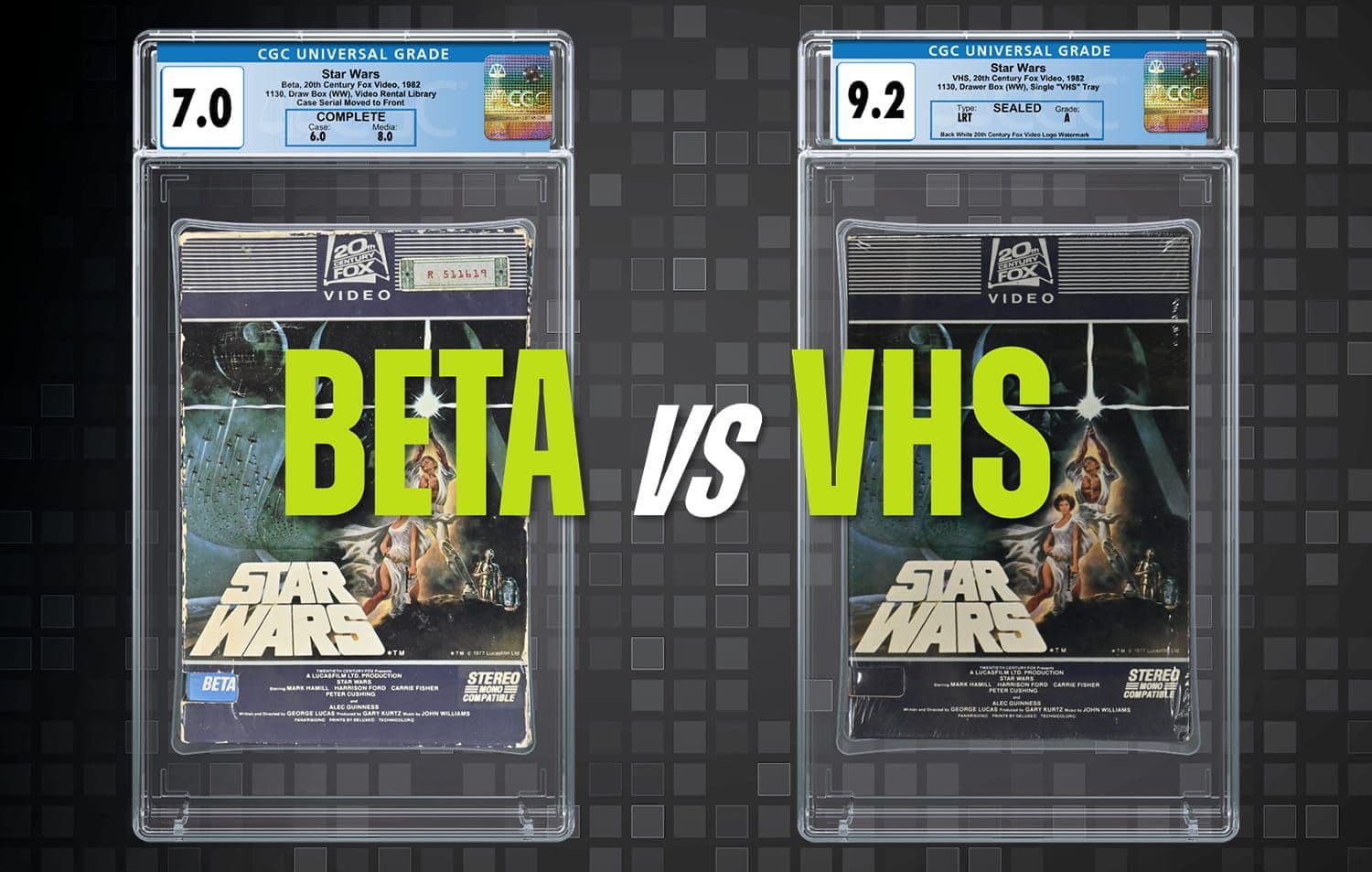The Case of Betamax Versus VHS

When CGC Home Video™ first launched in 2023, the company began by accepting submissions for two kinds of home videocassettes: VHS tapes and Betamax tapes. Nearly everyone knows what a VHS is, but what is a Betamax? Betamax is not simply a different brand of VHS videocassette. Instead, it is a completely different video format that fought VHS (Video Home System) for supremacy in the videotape format war of the 1980s. CGC Home Video grades both, and we’re here to help collectors understand the differences between the two longstanding videocassette formats.
Betamax vs. VHS — The Beginning
In the 1950s, Sony, Panasonic (then called Matsushita) and some other Japanese companies began creating and releasing the first video tape recorders. With these new devices came demand for a way to bring the technology to home audiences. In response, Sony released the Betamax videocassette in 1975, and JVC (Japan Victor Company) launched the VHS (Video Home System) in 1976. JVC intentionally launched the VHS at a lower price than Betamax, which officially lit the flames of the home video format wars.
The Differences Between Betamax and VHS Tapes
The most apparent difference between Betamax and VHS tapes is their size. Betamax tapes are almost an inch shorter and slightly less wide than the average VHS tape, but they have a thicker shell.
 |
|
| Back to the Future (1986) on Betamax (left) and VHS (right). | |
In terms of performance, Betamax was the clear winner. Sony’s videocassettes had better color and playback resolution, could fast-forward more quickly, and even had a “bookmarking” feature. However, this superior technology came with a hefty price tag. Seeing an opportunity, JVC produced simpler VHS machines using cheaper parts, which allowed them to undercut Sony in the secondary market. Although VHS tapes had less resolution because of these undercuts, they became the preferred videocassette by big market shareholders because they were cheaper and easier to get.
VHS tapes also had an advantage as far as recording times. When Betamax tapes first came to the home video market, they were only able to record an hour’s worth of programming. Meanwhile, VHS tapes could record for up to two hours — then up to six hours with later productions.
The Sounds of War
 |
|
| Star Wars (1982) on Betamax (left) and VHS (right). | |
Once both home video formats were on the market, it became a matter of which one — Betamax or VHS — could cement themselves as the most popular option with the public. The videocassettes were ultimately judged on two qualities: their ability to record for the home video market, and their affordability.
Although Betamax was the clear winner in performance and video quality and had the support of professionals within the home video industry, VHS was the clear favorite among film studios and the general public. Not only was VHS cheaper to produce, but it could record hours of footage, making it the best choice for home video production. Additionally, JVC edged VHS ahead of Betamax by building relationships with American film studios early to propel the launch of the home video rental market — using VHS as the primary catalyst for home video playback.
The Winner
In the end, Betamax’s superior picture, video and sound quality lost out to the preference for affordability. VHS’s cheaper production costs and longer recording times were vastly preferred by filming companies looking to make their mark in the home video rental market. Eventually, VHS overwhelmed Betamax in sales numbers and exploded in popularity, officially ending the format war in its favor.
Ironically, Sony and JVC stopped producing their respective videocassettes around the same time — sort of. Sony put out a statement in November 2015 announcing that they would cease production of Betamax tapes in 2016. VHS was a bit more complicated — film studios stopped releasing their films on VHS around 2007, but VHS players were still being produced and sold as combo VHS and DVD players. The last VHS player was produced by Funai Electric in 2016.
 |
|
| Disney released Cars on VHS in 2007, but it was exclusive to Disney Movie Club subscribers. It is one of the last known movies to be released on VHS. | |
In conclusion, although Betamax and VHS were both strong contenders for the incoming home video rental market, VHS managed to pull ahead because of its convenient recording times and cheaper production costs. Now that the home video market has switched to DVD, Blu-ray and streaming, videocassettes have become collector's items, which is where CGC Home Video comes in!
Grade your home video collection today!
Are you ready to elevate your old VHS and Betamax tapes to the true collectibles they are? Consider getting them graded by CGC Home Video! No matter what you collect, CGC Home Video is here to enhance your collection’s value, liquidity and security with expert and impartial grading services. Start grading today by creating a membership account. All you need is a free CGC account to submit collectibles for grading, but paid members receive discounts and other benefits. Learn more and select your membership level here.
About CGC
Since revolutionizing comic book grading in 2000, CGC has grown to include certification services for a vast variety of pop culture collectibles. These divisions include CGC Cards, CGC Video Games and CGC Home Video. CGC Cards provides expert card grading for sports cards, TCGs and non-sports cards. CGC Video Games is dedicated to video game grading for the most popular consoles, including Nintendo, Sega, Atari, PlayStation and more. CGC Home Video provides expert VHS grading in addition to other types of videocassettes, DVD, Blu-ray and more.